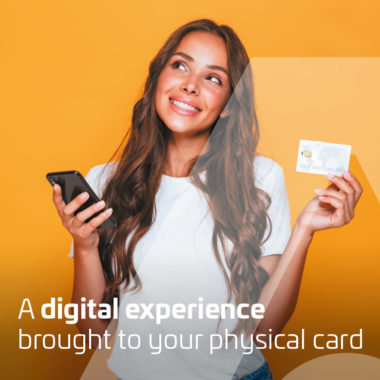While instant card issuance has become a common service for many banks, digital issuance, where banks can issue card credentials directly to a customer’s mobile wallet, looms as the next development to revolutionise the way consumers interact with their financial services provider.
However, while this innovation seems to only apply to the issuing of digital cards, digital issuance, in combination with a bank’s mobile app, has the potential to unlock a whole variety of different services for the consumer.
But first…
What is digital issuance?
Differing to instant card issuance, where payment cards can be immediately issued to a consumer when they head into a bank’s branch, digital issuance removes the physical interaction by issuing a bank card’s credential’s straight to the consumer’s mobile wallet or mobile banking app.
At a time where some consumers may want to keep physical contact to a minimum, digital issuance affords a greater level of flexibility to the ways in which a consumer can receive their card. In fact, according to research by OnDot, cards which are issued to digital wallets are nearly 100% activated and 70% are used within the five days, demonstrating the instantaneity and convenience digital issuance offers.
This flexibility, combined with the speed in which cards can be issued, could offer the perfect solution for consumers who are increasingly looking for convenience and efficiency from service providers in all parts of their lives.
The additional benefits of digital card issuance
In addition to the greater levels of convenience offered by the issuance of digital cards, its benefits extend even further. When combined with a comprehensive mobile app, financial services providers have the opportunity to deliver a broader range of services than just card procurement. Here are three broader benefits digital issuance can offer:
-
Enhancement of physical cards and digital cards
The future is neither fully digital nor fully physical when it comes to how consumers use their bank cards. Instead, digital issuance can create a future where both digital and physical cards complement each other, providing a consumer with the best possible banking experience, whether online or in-store.
Through a combination of digital issuance and a bank’s mobile app, new capabilities for physical cards and digital cards could diversify a bank’s portfolio of services.
In the case of physical cards, digital issuance could build the platform for the roll-out of services such as setting geographic spending limits, enabling or disabling contactless purchases and the ability to order numberless EMV bank cards. For the digital part, the virtual card could enable EMV tokenization services for digital wallets, as well as card in-app display.
Anchored in a bank’s mobile app, consumers can be put in full control of their digital and physical cards, providing them with a full repertoire of payment options.
- The right card for the right purchase
Today, consumers are always looking to get the best deal when it comes to buying goods and services. Whether accumulating loyalty points with their favourite supermarket or landing a killer discount when using a certain card at a particular retailer, there are several benefits that using the right card for a right purchase can bring to the consumer.
However, carrying one card for every different type of purchase is less than practical. But through digital issuance, consumers never have to worry about carrying a plethora of cards in their wallet.
As digital issuance can enable banks to issue digital cards directly to a mobile wallet, consumers are able to carry the virtual versions of every card they own, all conveniently stored on their smartphone.
-
Increased level of security
Core to any best-in-class financial service are the security measures to keep consumers’ financial data safe. And, unfortunately, criminal actors in the financial services space aren’t slowing down in their pursuit of consumers’ financial information. According to UK Finance, the total value of remote purchase fraud in the UK was £452.6 million in 2020, with the number of reported incidents of remote purchase fraud increasing by 12% to 2.4 million.
The security benefit of digital issuance is that credentials are shared directly with the customer, with no exchanging of details being made with any other party. What’s more, when sent to the consumer, a digital card’s credentials are safely stored within a mobile wallet or, alternatively, the bank’s mobile app.
In the case of the latter, the bank has the opportunity to leverage PSD2-level app security to delegate authentication to the mobile app, allowing a user to seamlessly authenticate their identity with the biometric features of their smartphone.
—
In an increasingly decentralised, mobile-based industry, the need to provide digital services which can be accessed remotely by consumers has become essential for banks. With digital issuance, banks can position themselves to offer a convenient and speedy issuance system, all the while enhancing their wider portfolio of services in the process.
Find out how in our white paper and discover how Instant issuance of physical cards offers a dramatic change to the UX
Interested and want to learn more? Leave a comment below and make sure to also follow us on Twitter at @ThalesDigiSec!



